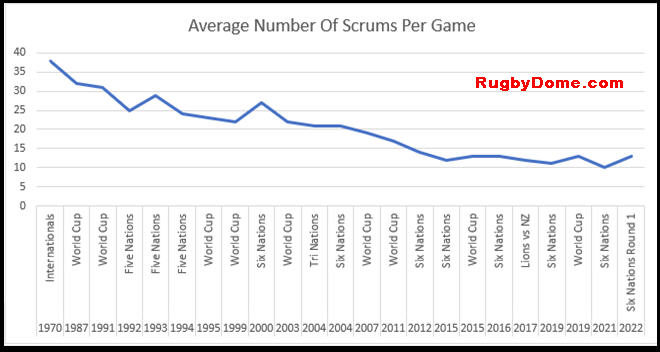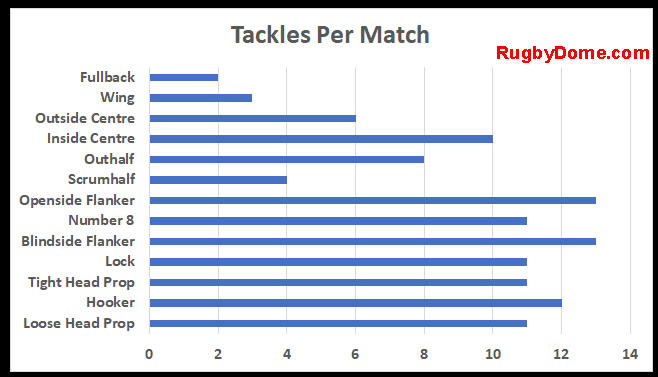You’ll find many different opinions on which position in rugby is the hardest to play.
If you ask a rugby player, they’ll probably pick the position they know best. But we’ve tried to keep subjective opinion out of our analysis
We’ve used a variety of qualities to measure and rank the positions in the order of most to least difficult.
What Is The Hardest Position In Rugby?
Tighthead prop is the hardest position in rugby based on a combination of high strength, specialist skills, high tackle rate, and the value contributed to the team.
Tighthead props need the strength to scrummage against two opposing forwards and excellent technique to keep the scrum steady.
They make a significant number of tackles per match, with an average that is only lower than hookers and flankers.
Other players make long runs, side-step tackles, and score many more tries. But tighthead props are key in tight play, using their strength in short bursts to eke out the hard yards.
Importance of scrums
Some commentators say that the importance of tighthead props has diminished as the number of scrums per match has declined over the decades.
However, there are still at least twelve in international matches.

If the tighthead prop can’t lock out the scrum throughout a match, that will be the loss of the game.
If the opposition gets a slight edge in the scrum and the number three shifts backward, attacking play is stifled as the opposing openside flanker gets a free run at the flyhalf.
If the tighthead prop keeps collapsing the scrum, the referee will whistle his team off the park.
Scrum penalties give the opposition territory, the opportunity to launch attacking plays, and the opportunity for three points from a kick at the posts.
Lock Is The Next Most Difficult Position
Lock forwards have the next most difficult position in rugby.
Locks must master the specialist skill of jumping to win lineouts. Although other players also jump, locks are responsible for about half of all lineout catches.
This has become even more important in the sport as the number of lineouts is considerably higher than the number of scrums. International matches have about twenty-five lineouts and they have become a key part of launching attacking play.
This is why locks are so important.
Aside from the lineout, locks make the same high number of tackles per match as tighthead props.
Their height and bulk are also key in mauls and tight play.

Positions Ranked By Difficulty
Here is our ranking of positions in rugby in the order of hardest to least difficult.
- Tighthead Prop
- Locks
- Outhalf
- Loosehead Prop
- Number 8
- Hooker
- Flankers
- Inside Centre
- Scrumhalf
- Outside Centre
- Fullback
- Wingers
Now that we’ve given you our ranking, it’s reasonable to ask how we came by this order.
The rest of this article explains our metrics. If you’re new to the sport, our overview of rugby positions will explain the basics.
How Rugby Dome Ranks Difficulty In Rugby
We used five measures to score each position.
Three of these are quantitative i.e. they are not our value judgments. These are:
- Average number of tackles per match
- The value placed on the position in terms of salary
- Whether the position is part of the traditional “spine” of a rugby team
Two of these measures are subjective. They are very real qualities, but they’re not as easy to assess as the number of tackles. These are:
- Special skills e.g. locking the scrum or kicking penalties
- Strength
Let’s explain each of these qualities in more detail.
Number of tackles

The number of tackles is the simplest. We have an article that analyses the statistics on the average tackle rate per rugby position at international level.
Fullbacks and wingers make the lowest number of tackles while flankers and hookers make the highest.
This is why adults who join a rugby club without experience are often put out on the wing for their first matches. Check out our article on the easiest position in rugby.
Ranking by salary
Our website has an extensive collection of articles on the salaries of rugby players in different countries. Just search the site for what you’re interested in.
In England, locks average as the highest-paid players while hookers are the lowest.
We shouldn’t rely too much on relative salaries to determine difficulty. But clubs must factor in how difficult or easy it is to replace a player in a specific position when handing out contracts.
The spine of the team
Most rugby coaches through history have defined the “spine” of a rugby team as the hooker, the number 8, the nine and ten, and the fullback.
These five players tend to lead the team on the pitch and make the key decisions. A new club builds up the spine first and then builds the team around those players.
Because of the involvement in tactical decisions on the field, we gave these five positions an extra point.
Specialist skills
Locks must hone their skills at jumping in the lineout while tighthead props never need that skill.
The outhalf and scrumhalf position requires the widest range of skills e.g. they must master all the different types of passing and kicking that exist in the game.
Did you know there are nine types of passing in rugby? A tighthead prop only needs to execute about three, while the nine must have them all.
We’ve ranked the positions in terms of the number of skills the players must master. This is fairly subjective!
Strength
The tighthead prop is stronger than a flanker, while a flanker is stronger than the scrumhalf.
Strength is important in rugby. Of course, the sport has vital roles for the smaller and slighter players who light up the backline.
But the stronger players must use their strength in rucks, mauls, and scrums. So we’ve given scores to the differing strengths of typical players in those positions.
Our Ranking Of The Difficulty Of Rugby Positions
Here is how our scoring played out. The last column in the table below is the total of the scores we’ve assigned the different measures.
| Position | Spine | Special Skills | Tackles | Strength | Value | Total |
| Tighthead Prop | 4 | 11 | 6 | 5 | 26 | |
| Locks | 2 | 11 | 3 | 8 | 24 | |
| Outhalf | 1 | 5 | 8 | 2 | 7 | 23 |
| Loosehead Prop | 3 | 11 | 5 | 3 | 22 | |
| Number 8 | 1 | 2 | 11 | 4 | 4 | 22 |
| Hooker | 1 | 3 | 12 | 4 | 1 | 21 |
| Flankers | 2 | 13 | 3 | 2 | 20 | |
| Inside Centre | 2 | 10 | 2 | 3 | 17 | |
| Scrumhalf | 1 | 5 | 4 | 1 | 4 | 15 |
| Outside Centre | 2 | 6 | 2 | 3 | 13 | |
| Fullback | 1 | 2 | 2 | 1 | 6 | 12 |
| Wingers | 1 | 3 | 1 | 2 | 7 |